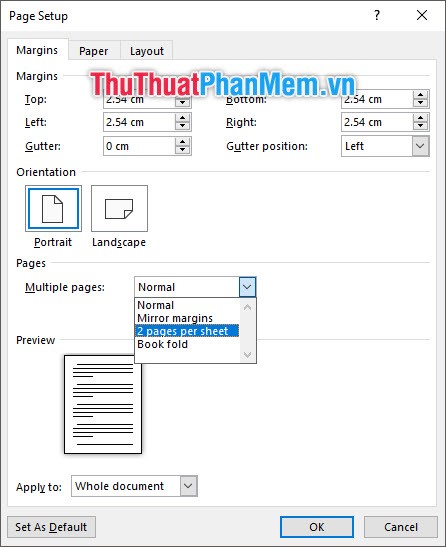

- #MAC MICROSOT WORD CHANGE PAGE LAYOUT FOR ONE PAGE FULL#
- #MAC MICROSOT WORD CHANGE PAGE LAYOUT FOR ONE PAGE VERIFICATION#
- #MAC MICROSOT WORD CHANGE PAGE LAYOUT FOR ONE PAGE PASSWORD#
- #MAC MICROSOT WORD CHANGE PAGE LAYOUT FOR ONE PAGE DOWNLOAD#
- #MAC MICROSOT WORD CHANGE PAGE LAYOUT FOR ONE PAGE MAC#
You will now have a Pages document you can open in the Pages app on a Mac or in Pages on iCloud. pages extension.Ĭlick the “ Export” button to export the file. The file name in the “ Save As” box defaults to the file name of the Word document with a. Then navigate to a folder in the next pane.
#MAC MICROSOT WORD CHANGE PAGE LAYOUT FOR ONE PAGE FULL#
If you opened the full “ Save As” dialog box, select a location in the left-most pane. If the folder in the “ Where” box is where you want to save the Pages file, click the “ Export” button here.
#MAC MICROSOT WORD CHANGE PAGE LAYOUT FOR ONE PAGE DOWNLOAD#
On the “ Choose a download format” dialog box, click “ Pages“. Then, right-click on the converted Word document and select “ Download a Copy” from the pop-up menu. Once the document is open, click the “ iCloud Pages” link in the upper-left corner of the app in the browser window to return to the Documents screen. Word files must be opened in Pages to completely convert them to the Pages format. Once you see the Word file on the Documents page, double-click on it to open it. It might take a bit of time to upload to your iCloud account, depending on how big the document is. doc) file onto the iCloud Pages app in the browser. To open a Word document in iCloud Pages, open a Finder window (Mac) or File Explorer (Windows). In your iCloud account, you can access Apple’s apps available also on Mac and iOS devices. You do not need to press “ Enter” to continue.
#MAC MICROSOT WORD CHANGE PAGE LAYOUT FOR ONE PAGE VERIFICATION#
If you’ve set up two-factor authentication on your Apple ID account, you’ll get a verification code on your iOS devices. On the iCloud page in your browser, enter your “ Apple ID” and “ Password” and press “ Enter“. You will now have a Word document you can open in Microsoft Word on a Mac or in Windows.Ĭonvert a Microsoft Office Document To Pages Using Pages In iCloud Is the folder in the “ Where” box where you want to save the file? If so, click the “ Export” button.Ĭlick the “ Export” button to export the file. If you see the compact version of the “ Save As” dialog box, and you want to use the full dialog box, click the down arrow to the right of the box.
#MAC MICROSOT WORD CHANGE PAGE LAYOUT FOR ONE PAGE PASSWORD#
If you want to password-protect the file, check the “ Require password to open” box, enter the password, verify the password, and enter a password hint. There are several other formats you can export your document to as well.Ĭlicking “ Advanced Options” allows you to specify whether to export the document as a. On the “ Export Your Document” dialog box, the Word tab is automatically selected. To convert Apple Pages to Microsoft Word using the Pages app, double-click on the.



Split the document window or remove the split Switch among the last four places in the document you edited Open the Search and Replace dialog box (Windows) / Find and Replace pane (Mac) Open the Navigation pane to search for text, images, more (Windows) / use the search box (Mac) Useful Word keyboard shortcuts Source: Microsoft Actionĭelete selection and copy it to the clipboard Note: On Macs, the ⌘ key is the same as the Command or Cmd key. For even more shortcuts, see Microsoft's Office site. Most work whether you’re using a subscription (Microsoft 365/Office 365) or non-subscription version of Word. We've listed the shortcuts we've found the most useful below. (Fewer shortcuts are available for the Mac, but you can create your own custom keyboard shortcuts if you like.) There are keyboard shortcuts to accomplish a vast array of tasks in the Word desktop client, in both the Windows and Mac versions. Why bother to lift your hands from the keyboard if you want to open or close a document, apply formatting to text and paragraphs, do a spell check, navigate through a document, or undo and redo actions? With keyboard shortcuts you won’t have to. Word’s Ribbon interface is great for finding everything you might ever want to do in the word processor - particularly things you don’t do frequently, like inserting footnotes or doing a mail merge.īut if you’re looking to do common tasks fast, you’ll find keyboard shortcuts far more useful.


 0 kommentar(er)
0 kommentar(er)
